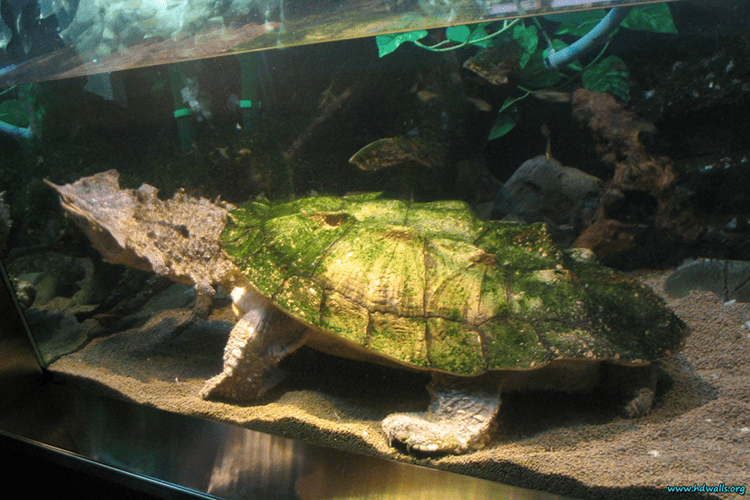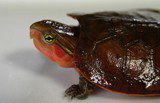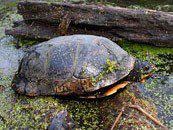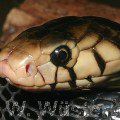
Fringed turtle (matamata)
Matamata is an exotic pet with a serrated shell, a triangular head and a long neck covered with outgrowths. Outgrowths are a kind of camouflage that allows the turtle to merge with aquatic plants. Matamata almost never leaves the water and prefers to be nocturnal. Unpretentious in content.
Matamata (or fringed turtle) belongs to the family of serpentine necks and is a very exotic pet. This is an aquatic predatory turtle, the highest activity of which occurs in the late evening.
The main feature of the species is an impressively long neck with rows of scalloped skin outgrowths, thanks to which, in the wild, the turtle merges with mossy branches and trunks of trees and other aquatic vegetation. The same outgrowths are found on the neck and chin of the turtle. The head of the matamata is flat, triangular in shape, with a soft proboscis, the mouth is very wide.
A peculiar carapace (upper part of the shell) with sharp cone-shaped tubercles on each shield and serrated edges reaches 40 cm in length. The average weight of an adult matamata is approximately 15 kg.
Gender can be determined by the shape of the plastron (the lower part of the shell): in males, the plastron is concave, and in the female it is even. Also, females have a shorter and thicker tail than males.
The coloration of matamata cubs is brighter than that of adults. The shell of adult turtles is colored in yellowish and brown tones.
When deciding to get a fringed turtle, you need to take into account that this pet can be admired from the side, but you can’t pick it up (maximum once a month for inspection). With frequent contact, the turtle experiences severe stress and quickly becomes ill.

Lifespan
The life expectancy of fringed turtles with proper care ranges from 40 to 75 years, and some researchers agree that turtles can live up to 100.
Features of maintenance and care
Due to their peculiar appearance, matamata are very popular among lovers of domestic amphibians. In addition, these are rather unpretentious turtles, but the arrangement of their aquaterrarium requires a responsible approach.
The aquarium for the fringed turtle should be spacious so that the pet, whose shell length is 40 cm, is free and comfortable in it (the best option is 250 liters).
Matamata are most active at dusk, they do not like bright light, so some areas in the aquaterrarium are darkened with the help of special screens fixed above the water.
The fringed turtle does not need islands of land: it spends almost all its life in water, getting out to land mainly for laying eggs. However, an ultraviolet lamp for turtles and an incandescent lamp are installed in the aquarium to prevent rickets in the pet. Optimum water level in the aquarium: 25 cm.
An unusual turtle came to us from hot countries, so its aquarium should be warm, if not hot: the optimum water temperature is from 28 to +30 ?С, air – from 28 to +30 ?С. An air temperature of 25 ° C will already be uncomfortable for the pet, and after a while the turtle will begin to refuse food. In the wild, fringed turtles live in dark waters, and the acidity of the water in a home aquarium should also be in the pH range of 5.0-5.5. To do this, fallen leaves of trees and peat are added to the water.
Matamat owners use aquatic plants and driftwood as decorations, and the bottom of the aquarium is covered with sand. It is also recommended to install a shelter for the turtle in the aquarium, where it can hide from the light: in the wild, on a bright day, turtles burrow into the mud.
Fringed turtles are predators. In their natural habitat, the basis of their diet is fish, as well as frogs, tadpoles, and even waterfowl, which turtles lie in wait for in ambush. In home conditions, their diet should also be based on meat. Turtles are fed fish, frogs, chicken meat, etc.
The condition of the water in the aquarium is carefully controlled: you will need a strong biological filter, clean water needs to be added regularly.
Matamata can form pairs throughout the year, but eggs are laid during autumn – early winter. Most often, one clutch consists of 12-28 eggs. Unfortunately, fringed turtles practically do not breed in captivity; this requires conditions as close as possible to wild nature, which is very difficult to achieve when kept at home.
Distribution
Long neck turtles are native to South America. Matamata live in stagnant waters from the Orinoco basin to the Amazon basin.
Interesting Facts:
Matamata breathes through the skin and almost never leaves the water.
Matamata rarely swims, and crawls along the bottom.





